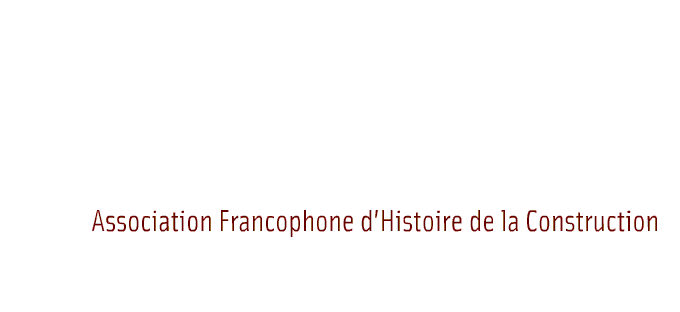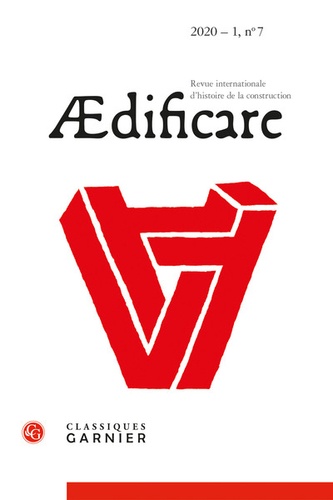Ædificare, 2020 – 1, n° 7
Revue internationale d’histoire de la construction
La septième livraison de la revue Ædificare est parue chez Classiques Garnier. Elle est disponible par abonnement ou par l’achat du numéro.
Ædificare est une revue semestrielle, internationale, multilingue et pluridisciplinaire couvrant le champ historique de la construction, toutes périodes et aires géographiques confondues. La revue dispose d’un Comité scientifique et d’un Comité de lecture internationaux. Tous les articles font l’objet d’une évaluation par les pairs en double aveugle. Elle paraît en publication papier et numérique aux éditions Classiques Garnier.
SOMMAIRE
Robert Carvais, Valérie Nègre
Éditorial. La vie des matériaux p.13-27
Editorial. The Life of Materials p. 29-43
L’éditorial s’intéresse au renouvellement des études sur les matériaux via les manifestations scientifiques, formations, offres de thèse pluridisciplinaires, leur patrimonialisation et leur analyse anthropologique. Il présente les articles du numéro autour de la certitude et du doute. Comment aborder l’incertitude ? Par l’analyse des antécédents, la préparation du terrain, la sécurisation des étapes ou l’usage de l’expertise. Comment revisiter une apparente certitude ? Par sa remise à plat, le séquençage d’une opération ou la constitution des sources d’une discipline.
The editors’ note focuses on the study of materials, which has been reinvigorated by scientific events, training, multidisciplinary thesis offers, their patrimonialization, and anthropological analysis. It introduces the articles in the issue in a key of certainty and doubt. How does one deal with uncertainty? By analyzing the antecedents, preparing the sites, laying the groundwork for the stages in the process, or using expertise. How does one revisit an apparent certainty? By rethinking it, sequencing an operation, or establishing the sources of a discipline.
Hélène Dessales
Construction et culture sismique à l’époque romaine / Constuction and Seismic Culture in Roman Times p. 45-76
Comment construire ou plutôt comment reconstruire, au lendemain d’un tremblement de terre ? Cette contribution analyse huit textes antiques (Ier siècle av. J.-C. – milieu du vie siècle), qui mettent en évidence quatre types de savoirs face aux tremblements de terre : l’observation, la prévention, la réparation et la simulation. Autant d’éléments qui permettent de préciser le développement d’une culture sismique, en explorant les rapports entre construction et risque à l’époque romaine.
How does one build–or rather how does one rebuild in the aftermath of an earthquake ? This contribution analyzes eight ancient texts (first century BC–mid-sixth century) that highlight four types of knowledge addressing earthquakes: observation, prevention, repair, and simulation. All these elements help to clarify the development of a seismic culture, exploring the relationship between construction and risk in Roman times.
Arnaud Timbert
Entre adoption et rejet. L’arc-boutant dans l’architecture des années 1130-1150 / Between Adoption and Rejection. The Flying Buttress in 1130s-1150s Architecture p. 77-95
Cet article propose d’évaluer les conditions qui déterminèrent l’usage prophylactique de l’arc-boutant sur les nefs « romanes » de Cluny III et de Vézelay durant les premières décennies du xiie siècle. Sur ce fondement l’étude aborde des monuments « gothiques » aux structures similaires pour lesquels l’arc-boutant a été tantôt adopté tantôt rejeté. Ces comparaisons permettent de mettre en lumière les débats qui animaient la communauté des bâtisseurs entre le début du XIIe et le début du XIIIe siècle.
This article aims to evaluate the conditions that determined the precautionary use of the flying buttress on the “Romanesque” naves of Cluny III and Vézelay during the first decades of the 12th century. On this basis, this study deals with “Gothic” monuments with similar structures where the flying buttress was sometimes adopted and sometimes rejected. These comparisons shed light on the debates that exercised the community of builders between the beginning of the twelfth and the beginning of the thirteenth centuries.
Philippe Bernardi
Une construction entre urgence et planification. Le transfert en ville du couvent des clarisses d’Aix-en-Provence dans la deuxième moitié du xive siècle / A Process of Construction between Emergency and Planning. The Transfer to the City of the Convent of Poor Clares of Aix-en-Provence in the Second Half of the 14th Century p. 97-149
Le repli en ville de nombreux couvents au xive siècle ne saurait être considéré comme un simple transfert. Installées à quelques distances d’Aix-en-Provence, les clarisses furent confrontées à ce problème. La conservation de plusieurs des registres notariés dans lesquels les religieuses firent enregistrer la plupart de leurs actes, entre 1361 et 1380, nous permet de suivre en grande partie la manière dont ces religieuses vécurent et gérèrent cette transition.
The retreat of many convents to cities in the fourteenth century should not be considered a simple relocation. The Poor Clares, who lived a few kilometers from Aix-en-Provence, were confronted with this problem. The preservation of several of the notarial registers in which the nuns recorded most of their actions between 1361 and 1380 allows us largely to follow the way in which these nuns lived and managed this transition.
Jean-Baptiste Javel
Réflexions sur les tracés préparatoires dans l’architecture en pierre de taille et dans la sculpture décorative de l’Aquitaine romane (xie-xiie siècles) / Considerations on the Preparatory Marks in the Stone Architecture and Decorative Sculpture of Romanesque Aquitaine (11th-12th Centuries) p. 151- 201
Vestiges fugaces d’opérations et de gestes techniques des anciens bâtisseurs, les tracés préparatoires sont peu étudiés pour les édifices du Moyen Âge central. Ce travail vise à mettre en avant la multitude de ces tracés aussi bien sur des blocs de parements que sur des blocs sculptés. Leur caractère discret et souvent fragile les rend difficiles à observer et à enregistrer, ils représentent néanmoins un important témoin du travail des bâtisseurs du Moyen Âge central (XIe-XIIe siècles).
Preparatory drawings are the fleeting vestiges of operations and technical gestures of bygone builders, and are little studied when looking at the buildings of the High Middle Ages. This work aims to highlight the abundance of these drawings on blocks of facings as well as on sculpted blocks. Their discreet and often fragile character makes them difficult to observe and record; they nevertheless bear crucial witness to the work of the builders of the High Middle Ages (eleventh–twelfth centuries).
Marco Conti
Popolo, contabilità e lavori pubblici. Pratiche amministrative e distribuzione delle risorse a Bologna alla fine del XIII secolo / Popolo, Accounting and Public Works. Administrative Practices and Distribution of Resources in Bologna at the End of the 13th Century p. 203-219
La contribution est centrée sur la gestion administrative des chantiers publics à Bologne à la fin du xiiie siècle. Dans un premier temps nous présenterons le système d’autorisation et de contrôle des dépenses. Ensuite, nous nous interrogerons sur le type d’informations fournies par les sources. Enfin, la question comptable sera mise en évidence, pour comprendre l’importance des travaux publics dans le budget de la commune et pour connaître les personnes impliquées dans ces travaux.
This contribution focuses on the administrative management of public building sites in Bologna at the end of the thirteenth century. First we will present the system of authorizing and controlling expenditures. Then we will examine the type of information provided by the sources. Finally, the question of accounting will be highlighted, in order to understand the importance of public works in the budget of the municipality and to acquaint ourselves with the people involved in these projects.
Sabine Kuban, James W. Campbell
Wasserkunst. German Books and Writers on Water and Hydraulic Engineering between 1533 and 1800 / L’art de l’eau. Livres allemands et auteurs sur l’eau et le génie hydraulique entre 1533 et 1800 p. 221-277
Cet article propose une étude de la littérature associée aux techniques hydrauliques sur la période 1500-1800 en s’appuyant en particulier sur les textes en langue germanique (originaux et traductions), parfois méconnus. La chronologie choisie permet de couvrir l’émergence de la pensée scientifique et l’influence grandissante de la théorie et des modèles mathématiques dans le domaine du « génie civil ». Elle permet ainsi de mener une réflexion critique sur l’histoire du génie hydraulique.
This article offers a study of the literature associated with hydraulic technology over the period 1500 to 1800, relying in particular on texts in Germanic languages (originals and translations), which are sometimes little known. The chronology chosen covers the emergence of scientific thought and the growing influence of mathematical theory and models in the field of “civil engineering,” facilitating a critical examination of the history of hydraulic engineering.
Gilles Bienvenu
Expertises et enjeux de pouvoir au xviiie siècle. L’affaire du pont Feydeau à Nantes (1727-1737) / Expertise and Power Games in the 18th Century. The Case of the Feydeau Bridge in Nantes (1727-1737) p. 279-387
Entre 1727 et 1737, les procédures ouvertes concernant la solidité du pont Feydeau à Nantes, la recherche des responsabilités après l’écroulement d’une arche lors du décintrement, puis la réception de l’ouvrage reconstruit, sont ponctuées par quatre expertises. Les enjeux portés par les divers acteurs, au-delà des considérations constructives, révèlent des moments d’histoire professionnelle et institutionnelle resitués sur l’échiquier des alliances et des conflits, et sur la réception et l’usage de ces expertises.
The proceedings initiated between 1727 and 1737 looking into the soundness of the Feydeau Bridge in Nantes, the search for responsibility after the collapse of an arch during the removal of supports, and then the acceptance of the reconstructed structure, were punctuated by four expert appraisals. Beyond the construction considerations, the issues raised by the various actors reveal instances from professional and institutional history resituated on the chessboard of alliances and conflicts and on the reception and use of this expertise.
COMPTES RENDUS
Marco Rosario Nobile, Federica Scibillia (éd.), Tecniche costruttive nel Mediterraneo. Dalla sterotomia ai criteri antisismici (Hélène Dessales) p. 391-394
Yaron Pesztat (éd.), Blaton. Une dynastie de bâtisseurs. Een dynastie van bouwers (Jelena Dobbels) p. 395-398
COMPENDIA
Construction and Seismic Culture in Roman Times (Hélène Dessales) p. 401-402
Between Adoption and Rejection. The Flying Buttress in 1130s-1150s Architecture (Arnaud Timbert) p. 402-403
A Process of Construction between Emergency and Planning. The Transfer to the City of the Convent of Poor Clares of Aix-en-Provence in the Second Half of the 14th Century (Philippe Bernardi) p. 404-405
Considerations on the Preparatory Marks in the Stone Architecture and Decorative Sculpture of Romanesque Aquitaine (11th-12th Centuries) (Jean-Baptiste Javel) p. 405-406
Popolo, Accounting and Public Works. Administrative Practices and Distribution of Resources in Bologna at the End of the 13th Century (Marco Conti) p. 406-407
Wasserkunst. German Books and Writers on Water and Hydraulic Engineering between 1533 and 1800 (James W. Campbell, Sabine Kuban) p. 408-409
Expertise and Power Games in the 18th Century. The Case of the Feydeau Bridge in Nantes (1727-1737) (Gilles Bienvenu) p. 409-410
Présentation des auteurs et résumés /Abstracts p. 411-418



